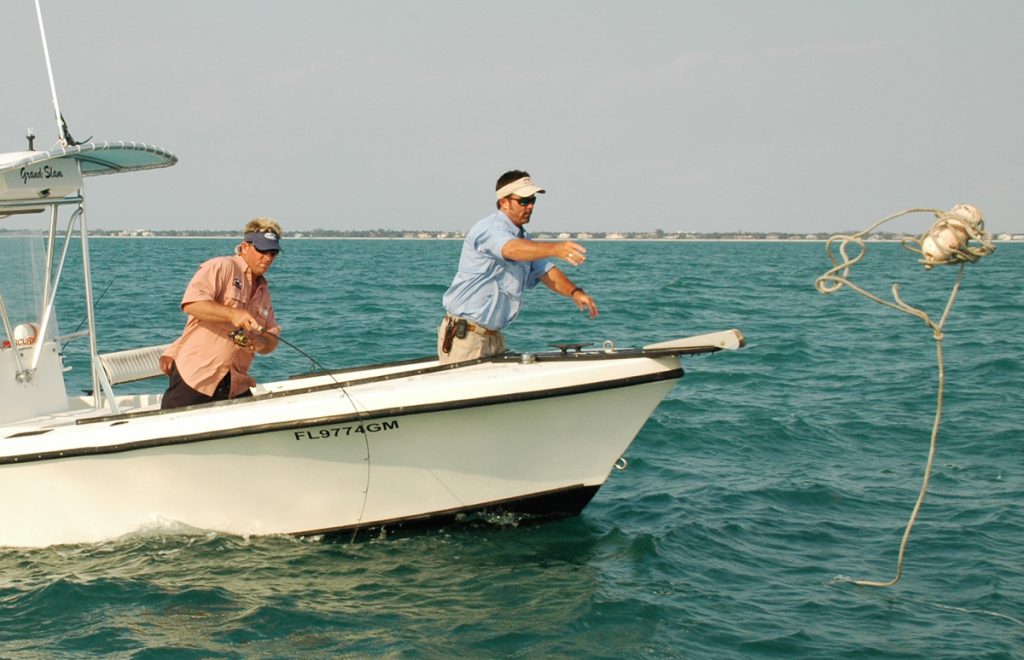July 15, 2014
By Will Geraghty
Chasing big fish in tight quarters? Rig a quick-release float to get off the anchor quick.
 And off we go! With the angler hooked up to a fish that needs to be followed, the quick-release float line gets tossed before pursuit.
And off we go! With the angler hooked up to a fish that needs to be followed, the quick-release float line gets tossed before pursuit.
On Florida's nearshore and offshore reefs, we often find ourselves hooked up and over-matched to tackle-busting species such as permit, cobia and king mackerel. While the finest braided lines, high-speed reels, situation-specific rods and marine electronics do a great job of putting us into position, getting out of a sticky situation is just as important.
Never overlook the basic yet paramount strategy for getting “off” the anchor and mobile shortly after hooking up. It's a skill certain one day to prove the difference between an epic dockside
tale of defeat or perhaps hero status among your peers.
Once tight to the anchor rode, upcurrent or forward of the targeted fish haven, anglers will have an advantage to fool fish cycling or patrolling the mid to upper reaches of the water column foraging on shrimp, crabs and baitfish.
It's exciting when you hook a good fish—line ripping off the reel, rod bent to its limit—but suddenly you have a serious question. Should I remain at anchor and attempt to conquer the fish or should I get off “the hook” to avoid getting spooled or rocked up?
Anglers prepared for this make it look easy by having rigged and at the ready a breakaway/release anchoring system. Those new to the light tackle wreck rodeo will inevitably struggle during their first round or two.
The decision to get mobile is purely out of necessity. Also consider etiquette—if you drop the anchor and chase a runaway fish, will you be disrupting other anglers anchored nearby?
 The bright float clipped to a loop in the anchor line allows for quick departure from anchor and marks the anchor line for retrieval.
The bright float clipped to a loop in the anchor line allows for quick departure from anchor and marks the anchor line for retrieval.
As a guide, I often select locales which receive minimal pressure, allowing me to take full and free advantage of a breakaway/release anchoring system. My system is somewhat crudely fashioned yet ultra-effective. Hooking big fish and getting mobile is a part of my wreck equation and should be yours as well.
Consider the following basic supplies and fabrication steps in developing your own breakaway anchoring system:
›› Approximately 4 to 5 feet of 3/8- to ½-inch marine grade rode or braided dock line.
›› Twelve-inch or greater in diameter anchor ball or styrofoam float.
›› Two stainless marine snap clips (optional).
Use an anchor hitch knot or splice the snap clips to both ends of the rope. Attach one end directly to the float of choice.
On the scene and firmly set to the anchor, remove all the remaining anchor rode from its storage locker and place it orderly on the bow or forward cap deck. Complete the system by clipping the line and float to the anchor line through pre-tied or spliced loops, or fasten it directly to the anchor line with a bowline
knot.
Now, upon hooking that runaway fish you have the ultimate freedom to remove your anchor from the cleat, throw/deploy your entire system instantly to commence the chase. The buoy will, additionally, safely mark and assist in locating the anchor line after what is hopefully a successful light tackle battle.
Couple of tips:
›› Write your vessel name in paint or permanent marker on the marker buoy, along with something to the effect of “We'll be back!”
›› Strategically plan your anchor rode lengths, so that you aren't dumping an extra 100 feet of rode on top of what's already out. In strong current, that extra rode poses a hazard as it quickly drifts back toward your prop while you're getting into gear. Best to drop as little rode as necessary.
If you're fishing mostly 20 to 40 feet of water, have some form of snap clip at the end of the first 100-foot section of anchor rode. Be prepared to add more in 50- to 100-foot sections, if you'll be fishing deeper. With adequate chain (10 to 15 feet), you'll need in rode about 3 times the depth for fishing applications—and up to 7 times for long-term anchorage.
›› Don't forget to retrieve your buoy and your anchor! FS
First Published Florida Sportsman Dec. 2012
